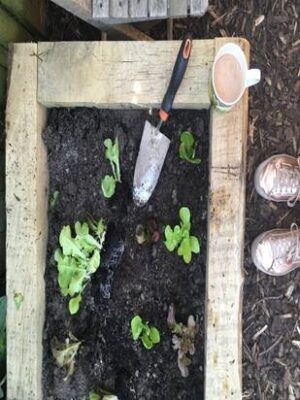I have some small lettuce seedlings that I started in the greenhouse and it is time to plant them out and get some summer salads going. The weather has been so very wet here in the southwest of England this spring that the garden is well behind, and the only work that has really occurred is in the greenhouse. The soil outside is sodden, but the raised beds that are just outside the greenhouse are in a better state, and I think we can just about get away with planting into them during a brief break in the endless rain.

I do plant lettuce plants inside the greenhouse in the winter. Some such as ‘Arctic King and ‘Winter Density’ are really pretty hardy, as their names suggest, and they do really well with the protection of the cold glasshouse keeping the leaves clean and soft. No heat required, they will grow during mild spells and sit still during colder ones, and it means that we always have a little something fresh to go out and pick, even in the dead of winter. Lettuces really don’t mind cool weather, and they have hot weather – they will bolt, or run to flower and seed, as soon as they get too hot. Although that doesn’t feel very likely at the moment, warmer days are (surely) coming, and so it makes no sense to plant any more indoors now. They are also great in shade for exactly this reason, and so are really useful to plant in the shady little raised bed that I have that doesn’t suit many other edibles. In shade and mild cool weather these lettuces will soon bulk up for summer salads.
Parsley also likes shade and also gets planted in this bed, and it needs to be sown now. It takes a long time to germinate and it used to be said that its root went down to hell and back seven times before it sprouted. Because of this it was traditionally planted on Good Friday when it was said that the devil had no jurisdiction over the soil (along, incidentally, with potatoes for similar reasons). We’ve missed that chance unfortunately for this year but it is still worth getting it into the soil as early as possible so that it can begin its lengthy germination.
At the other end of this small shady bed I am thick sowing some peas to harvest as pea shoots, which will grow a few inches and then I will cut them as these young shoots make a delicious salad ingredient, tasting of peas, but in leaf form. Peas do need sun, and wont do well in shade, but that is if you are growing them to flower and produce peas. If you are just growing them for shoots the need for sun is much less, and they should do fine. I buy a packet of dried marrowfat peas from the supermarket and sow them very thickly, lightly covering them with soil. It would be very expensive to buy enough ‘proper’ seeds to get a good crop of pea seedlings, and also a waste: we don’t need them to be the best at producing lots of flowers, or to make the most succulent and even pea pods, as we are going to cut and eat them well before they reach that stage. All that breeding and care would be for nothing.
If you have a little more space in a shady bed you could also add mint, but plant it into a terracotta pot and then sink the pot into the soil, not quite to soil level – mint is an aggressive grower and if you plant it out your lovely shady bed full of a variety of salads will very soon be a mint bed only.


